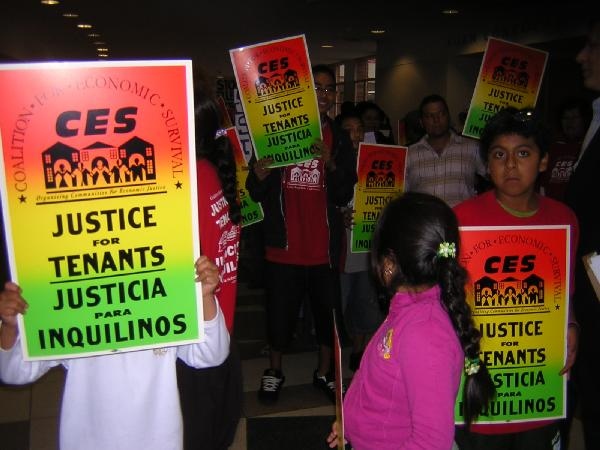
CALIFORNIA TENANTS DEMAND REFORM
CalPERS will lose hundreds of millions of dollars in predatory real estate investment schemes according to recent reports in the New York Times, the Wall Street Journal, the San Jose Mercury News, and other publications. What has not been adequately reported is that these schemes are classic examples of what housing advocates call “predatory equity,” over leveraged investments that rely on the displacement of tenants from rent-regulated housing in order to turn profits.
CalPERS has effectively invested (and lost) the retirement funds of working people in projects that were designed to displace working people from their homes.
Tenants Together is calling on CalPERS to adopt predator-free real estate investment policies that will prevent it from ever again committing funds to these types of schemes that have displaced tenants and have proven to be such financial disasters. Tenants Together is also demanding a full investigation into the circumstances of CalPERS investments in predatory equity schemes to determine what CalPERS knew about these investments at the outset.
“CalPERS must never again make investments into schemes that are so devastating to local communities and to the retirement accounts of working people,” said Dean Preston, Executive Director of Tenants Together. “We need to know exactly how this happened so we make sure it never happens again.”
CalPERS, the nation’s largest pension fund, will lose $600 million in two separate real estate investment deals: one in New York City with partners Tishman Speyer Properties and BlackRock Realty and another in East Palo Alto, CA with partner Page Mill Properties. Both investments have been the subject of considerable controversy as they have involved the mass displacement of low and moderate income tenants from their homes. They have also spawned multiple lawsuits and raised the ire of tenants, community organizations, public officials, and labor groups.
For more than a year, Tenants Together has been working with tenants, advocates, labor unions, and city officials in East Palo Alto, where CalPERS’ investment partner, Page Mill Properties, has been engaged in open conflict with the city and its residents. In 2006 Page Mill Properties began buying up some 1800 units of rent-controlled housing on the west side of East Palo Alto bordering an affluent neighborhood of Palo Alto. After acquiring the properties, Page Mill began implementing drastic rent increases (many far in excess of the annual increase permitted under the city’s rent stabilization ordinance) and forcing many tenants to leave their homes through unaffordable rents, harassment, and eviction lawsuits.
After learning that CalPERS was a principal investor in the project, Tenants Together, along with advocates and tenants from East Palo Alto met with CalPERS staff and testified before the CalPERS Board of Administration bringing the crisis to their attention and calling on them to intervene with their partner Page Mill to move it to rescind the rent increases and cease the unjust eviction of its tenants. Tenants Together also warned that predatory equity investments were extremely risky financially and reputationally for CalPERS.
Yet for months after, the situation continued to deteriorate in East Palo Alto as evictions and litigation continued. Finally, last month, Wells Fargo Bank reported that Page Mill was in danger of losing its properties after missing a $50 million mortgage payment. Soon after, its properties were put into receivership as an initial step towards foreclosure. If the foreclosure proceeds, as appears to be likely, CalPERS will lose all of its $100 million investment.
At the same time as its troubles in East Palo Alto reached a critical stage, CalPERS’ investment with Tishman Speyer Properties and BlackRock Realty in New York City began to go bust as well. In this instance, a half a billion dollars worth of CalPERS retirement money was at stake. Again, it appears CalPERS will lose the entire investment.
Three years ago, Tishman Speyer and BlackRock devised a plan to buy Stuyvesant Town and Peter Cooper Village in New York City for $5.4 billion, a purchase that would amount to the largest real estate deal in American history. But as is the case with all predatory equity investment schemes, the buyers paid more for the property than could be justified by the rental income that the property was earning at the time of sale.
However, as the Wall Street Journal reports today (“An Apartment Complex Teeters,” 10/15/09), “the new owners predicted they would be able to convert thousands of protected apartments to higher market rents. These projections convinced CalPERS and the pension funds of several other states to make large equity investments in the deal.”
In other words, profit was expected to come at the expense of lower income tenants who would be pushed from their homes and replaced with higher-rent-paying tenants and knowing this, CalPERS signed on.
Apparently, like Page Mill, Tishman/BlackRock did not count on the fact that tenants would not so easily be forced from their homes. In the case of both of these schemes, tenants organized and resisted displacement. They dug in, brought their stories to the media, staged rallies, and filed lawsuits against the predatory investors. It now appears the tenants may outlast their landlord foes, though the future of these soon-to-be foreclosed properties remains uncertain.
Tenants Together, along with many other organizations and advocates from the affected communities, have pointed out that CalPERS, a co-author and signatory to the UN Principals for Responsible Investment, should never have invested in these kind of schemes that seek to displace low and moderate income tenants.
It remains unclear how much CalPERS initially knew about the nature of its investment with Page Mill because, as real estate reporter Sharon Simonson explains, (“Palo Alto Developer Losing $340 million with CalPERS Money,” The Registry, 9/9/09) the pension fund has “remained stubbornly mute on Page Mill’s activities or plans.”
Tenants Together requested from CalPERS a copy of Page Mill’s investment proposal to CalPERS, and the resulting investment agreement, via a Public Records Act request but the pension fund denied the request on the grounds of confidentiality.
The fact that CalPERS remains “stubbornly mute” on its investment with Page Mill leaves observers to guess between two troubling possibilities. Either CalPERS was unaware of the true nature of Page Mill’s plans for East Palo Alto, which is quite problematic in terms of the fund’s fiduciary responsibilities to its members, or it was aware of Page Mill’s plans, which is terribly problematic in terms of basic humane practices from a public pension fund that takes pride in its reputation for ethical investments.
Either way, “predator free” real estate investment policies must be adopted to prevent further investments of this type in the future.
Tenants Together has proposed “predator free” investment policies to CalPERS, similar to guidelines recently adopted by the Comptroller in New York City, to prevent pension fund investments in predatory equity schemes. To date, CalPERS has done nothing to move forward on adopting such a policy.









